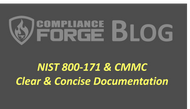Clear and Concise CMMC Policies & Procedures
Posted by ComplianceForge Support on Jan 22, 2024
In the ever-evolving landscape of cybersecurity and data protection, organizations face the formidable challenge of adhering to regulatory frameworks such as NIST 800-171 and CMMC (Cybersecurity Maturity Model Certification). Among the myriad of tasks required for compliance, the significance of clear and concise documentation cannot be overstated. This article delves into why meticulous documentation is the unsung hero in ensuring organizations' readiness for NIST 800-171 and CMMC compliance.
Ryan Bonner, CEO and founder of DEFCERT believes clear, concise, and well-mapped documentation is critical for responding to external verification of frameworks such as NIST 800-171 and CMMC. He states, "Pointing external assessors towards a large binder of governing documents slows down assessments and creates a risk of unnecessary findings. When policies, standards, procedures, and other core documents are well-mapped to regulatory requirements, organizations can direct an assessor to the exact paragraph or statement needed to satisfy assessment objectives. We've seen strong documentation reduce assessment duration by several days. Those time savings generally translate to internal and external cost savings related to assessments and certification efforts."
Reinforcing the points stated by Mr. Bonner, the reality is that time is money in a CMMC assessment. Efficient, concise documentation makes it easier for assessors to identify evidence, which reduces labor. On the other hand, inefficient documentation increases the labor associated with an assessor to locate necessary evidence. Clear and concise documentation can pay for itself in saved assessment fees.
The Regulatory Landscape of NIST 800-171 & CMMC
NIST 800-171 and CMMC serve as robust frameworks designed to safeguard sensitive/regulated data and enhance the cybersecurity posture of organizations, particularly those contracting with the U.S. Department of Defense (DoD). These frameworks outline a set of controls, processes, and measures that organizations must implement to protect Controlled Unclassified Information (CUI) and other sensitive data.
The Role of Documentation:
- Comprehensive Understanding: Clear documentation serves as the cornerstone for a comprehensive understanding of the requirements outlined in NIST 800-171 and CMMC. It provides a roadmap for organizations to navigate through the complexities of these frameworks and ensures that every stakeholder comprehends their role in achieving compliance.
- Traceability and Accountability: Documentation acts as a trail of breadcrumbs, enabling organizations to trace their compliance efforts. Every action, policy, or procedure must be documented, establishing accountability throughout the organization. This traceability is crucial for audits and assessments, demonstrating a commitment to compliance over time.
- Risk Management: Effective risk management is at the heart of cybersecurity compliance. Clear documentation facilitates the identification, assessment, and mitigation of risks associated with handling sensitive/regulated data. This proactive approach not only ensures compliance but also enhances the overall security posture of the organization.
- Communication and Training: Documentation serves as a means of communication within the organization. Clear and concise documents become valuable training resources, aiding employees in understanding and implementing security measures. This, in turn, fosters a culture of cybersecurity awareness and compliance.
- Adaptability and Scalability: As cybersecurity threats evolve, organizations need to adapt quickly. Well-documented policies and procedures provide a foundation for scalability and adaptability, allowing organizations to respond effectively to emerging threats without compromising compliance.
Best Practices for Documentation:
- Plain Language: Use clear and straightforward language to ensure that documentation is easily understood by all stakeholders, regardless of their technical expertise.
- Consistency: Maintain consistency in formatting, terminology, and structure across all documentation to avoid confusion and streamline comprehension.
- Version Control: Implement a robust version control system to track changes, updates, and revisions to documentation, ensuring that the most current information is always accessible.
- Accessibility: Ensure that documentation is readily accessible to all relevant parties. This includes employees, auditors, and any other stakeholders involved in the compliance process.
In the intricate landscape of NIST 800-171 and CMMC compliance, the role of clear and concise documentation cannot be overstated. It serves as the glue that binds the various elements of cybersecurity and data protection together, offering organizations a roadmap to compliance and resilience against emerging threats. As organizations embark on the journey to fortify their cybersecurity defenses, they must recognize the pivotal role that documentation plays in the quest for regulatory compliance and overall information security.

